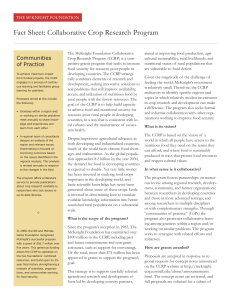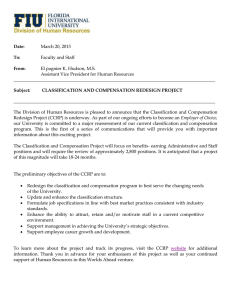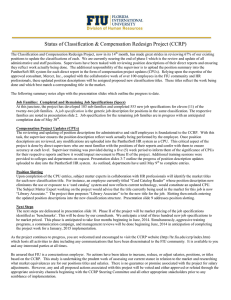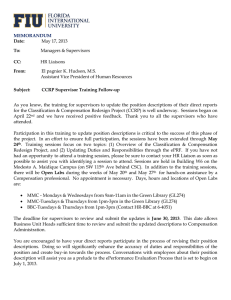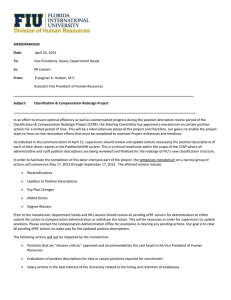CCRP Program Guidelines - Collaborative Crop Research Program
advertisement
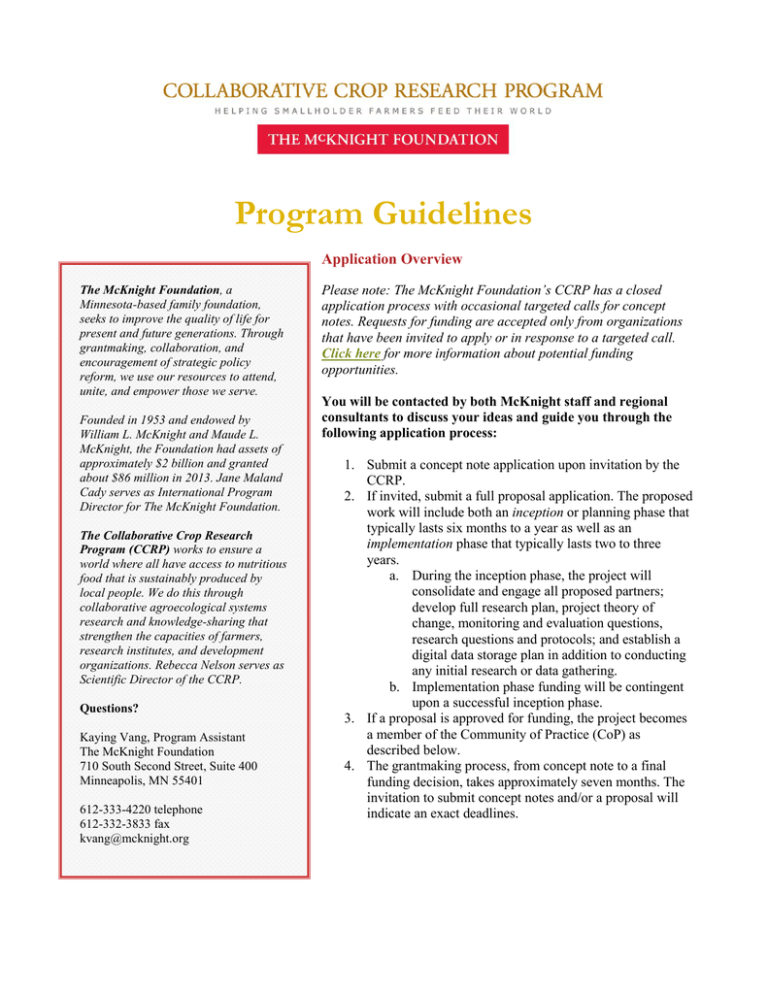
Program Guidelines Application Overview The McKnight Foundation, a Minnesota-based family foundation, seeks to improve the quality of life for present and future generations. Through grantmaking, collaboration, and encouragement of strategic policy reform, we use our resources to attend, unite, and empower those we serve. Founded in 1953 and endowed by William L. McKnight and Maude L. McKnight, the Foundation had assets of approximately $2 billion and granted about $86 million in 2013. Jane Maland Cady serves as International Program Director for The McKnight Foundation. The Collaborative Crop Research Program (CCRP) works to ensure a world where all have access to nutritious food that is sustainably produced by local people. We do this through collaborative agroecological systems research and knowledge-sharing that strengthen the capacities of farmers, research institutes, and development organizations. Rebecca Nelson serves as Scientific Director of the CCRP. Questions? Kaying Vang, Program Assistant The McKnight Foundation 710 South Second Street, Suite 400 Minneapolis, MN 55401 612-333-4220 telephone 612-332-3833 fax kvang@mcknight.org Please note: The McKnight Foundation’s CCRP has a closed application process with occasional targeted calls for concept notes. Requests for funding are accepted only from organizations that have been invited to apply or in response to a targeted call. Click here for more information about potential funding opportunities. You will be contacted by both McKnight staff and regional consultants to discuss your ideas and guide you through the following application process: 1. Submit a concept note application upon invitation by the CCRP. 2. If invited, submit a full proposal application. The proposed work will include both an inception or planning phase that typically lasts six months to a year as well as an implementation phase that typically lasts two to three years. a. During the inception phase, the project will consolidate and engage all proposed partners; develop full research plan, project theory of change, monitoring and evaluation questions, research questions and protocols; and establish a digital data storage plan in addition to conducting any initial research or data gathering. b. Implementation phase funding will be contingent upon a successful inception phase. 3. If a proposal is approved for funding, the project becomes a member of the Community of Practice (CoP) as described below. 4. The grantmaking process, from concept note to a final funding decision, takes approximately seven months. The invitation to submit concept notes and/or a proposal will indicate an exact deadlines. Program Background The McKnight Foundation’s Collaborative Crop Research Program (CCRP) funds participatory, collaborative research on agroecological intensification (AEI). Funded projects typically link international, national, and local organizations with communities of smallholder farmers, researchers, development professionals, and other parties. Projects work together as part of a Community of Practice (CoP) to generate technical and social innovations to improve nutrition, livelihoods, and productivity for farming communities in Africa and South America. Large-scale impact is realized when new ideas, technologies, or processes are adapted, when insights from research catalyze change in policy and practice, and when innovation inspires further success. Agroecological Intensification (AEI) is defined as improving the performance of agriculture through integration of ecological principles into farm and system management. Depending on the context, improved performance may mean any or all of the following: increased productivity, enhanced use of local resources, maximized returns from external inputs, improved stability, and/or diversity of diets, with associated increases in resilience and environmental service provision from farmed landscapes. Characteristically, AEI: Uses local and global knowledge to improve efficiency and effectiveness of crop, tree, livestock, pest and disease, and soil management; Enhances soil health and fertility, increases functional diversity, and reduces pre- and post-harvest losses; Contributes to the development of local value chains and diverse and nutritious human diets; Is flexible and responsive to local conditions, including farmers’ access to inputs and markets; Is based on evolving understanding of biophysical, socioeconomic, cultural, gender, climate, and other contexts; Reduces risk and increases productivity through enhanced resilience and adaptation; Requires cross-sector, multilateral collaboration. Local people and organizations are recognized under the CCRP’s place-based approach as having a nuanced understanding of the challenges their regions face in improving nutrition, livelihoods, and productivity. In CCRP-funded research, grantees develop quality, long-term partnerships among stakeholders. Knowledge sharing among partners reinforces local agency and increases the potential for sustainable solutions. What the CCRP Funds & Where The CCRP focuses on four regions of high food insecurity, funding projects that complement and enhance regional and programmatic grant portfolios. Grants are selected based on criteria that include alignment with regional priorities and strategies, quality and innovation, and awareness of gender and climate issues. Grantees become members of a community of practice (CoP). The CoP model emphasizes networking, learning, and collective action. A number of CCRP activities help promote vibrant communities of practice: Grantmaking strategy driven by regional needs and opportunities Annual grantee meetings (travel costs to attend are included in each grant) Training and technical assistance, both grantee-led and initiated by the CCRP Peer learning and teaching around integrated monitoring, evaluation, and planning (IMEP), research methods, common interest topics, etc. Peer review for publication support Regional Strategies and Teams Follow the links below for additional information about each region of funding and the CoP. Andes CoP (Bolivia, Ecuador, and Peru) supports integrated and diverse production systems that embrace conservation and native agricultural biodiversity. This region is supported by Carlos Perez and Claire Nicklin. East & Horn of Africa CoP (Ethiopia, Kenya, and Uganda) aims to improve farming systems performance and, through greater crop diversity, to enhance local diets and livelihoods. This region is supported by Beth Medvecky and Linnet Gohole. Southern Africa CoP (Malawi, Mozambique, and Tanzania) targets research on constraints to legume productivity and also to improvements in crop productivity and post-harvest practices. This region is supported by Tim Chancellor and Prudence Kaijage. West Africa CoP (Burkina Faso, Mali, and Niger) strives to enhance productivity and nutritional contributions of sorghum and pearl millet-based production systems via agroecological intensification, diversification with legumes and minor crops, improved tree-livestock integration, and development of local value chains. This region is supported by Bettina Haussmann and Hamado Tapsoba. Selection Criteria The CCRP funds research that supports technical and social innovation for improving nutrition, livelihoods, and productivity. It is guided by the CCRP Theory of Change. In reviewing proposals, McKnight considers the following: Are the project approach and focus aligned with CCRP theory of change? Does the project contribute to advancements in agroecological intensification? Is the focus on improving key aspect(s) of small-scale agriculture within regional food systems and in ways that improve the food security, income, and nutrition of resource-poor rural households? Does the project demonstrate a systems perspective, including consideration of factors such as crop improvement and seed access; pest/disease management; soil and water management; strengthening of farmer organizations; enhancing market access; nutrition research and education; and/or capacity building, as well as contextual issues related to equity, resilience, sustainability, self-determination, the political context, gender equity, and climate change? Is the project design appropriate for addressing the problems identified in the food and agriculture systems? Does the project design show a likelihood of positive impact for resource-poor farm families? Is there authentic collaboration and partnership that involves research, development, community- based organizations, farmers, and the private sector as appropriate and necessary, and also innovative approaches as appropriate? Does the project demonstrate cultural and gender sensitivity? What is the project’s ability to contribute improved “public goods” knowledge and practice beyond its specific sites, contexts, and objectives?
